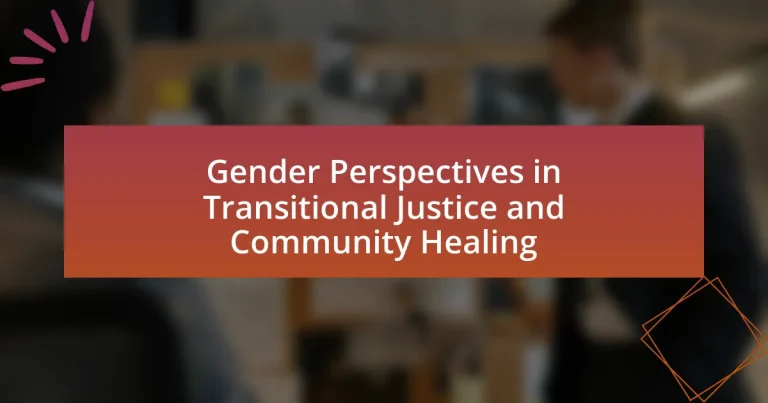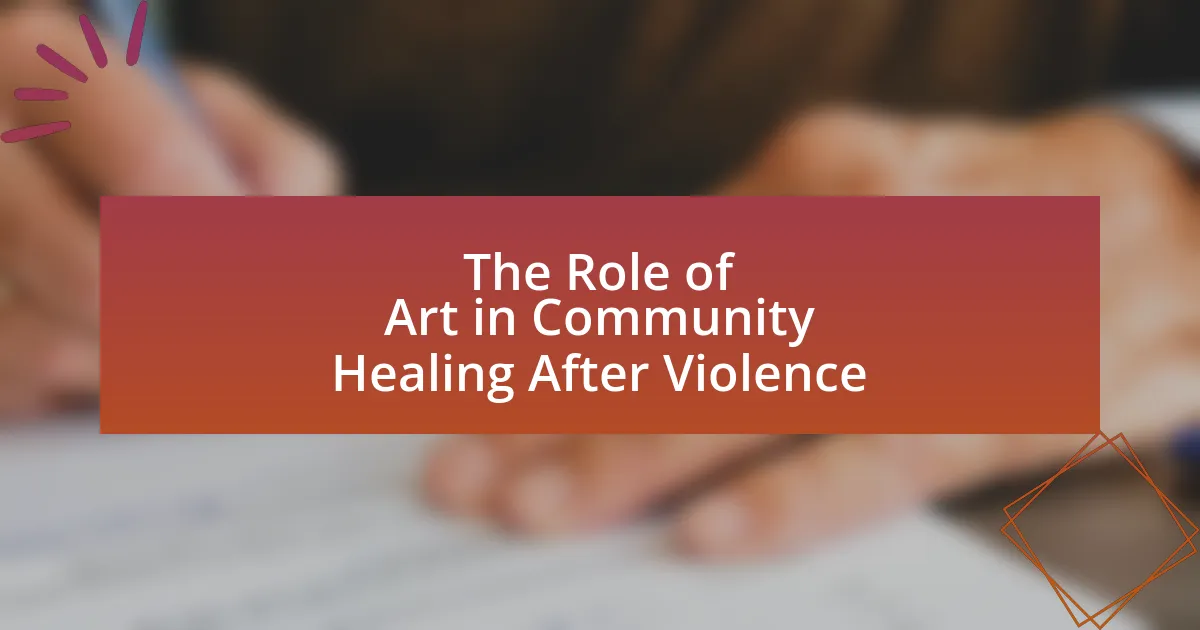Gender perspectives in transitional justice and community healing involve integrating gender analysis into processes that address past human rights violations and promote societal recovery. This article examines how gender perspectives influence transitional justice by recognizing the distinct experiences and needs of different genders, particularly women and marginalized groups, who are disproportionately affected by conflict and injustice. It highlights specific gender issues that arise during transitional justice, such as underrepresentation in decision-making and the prevalence of gender-based violence, and discusses the impact of these issues on community healing. Additionally, the article outlines best practices for implementing gender-sensitive approaches, the role of cultural norms, and the importance of inclusive frameworks to enhance justice outcomes and promote sustainable peace.
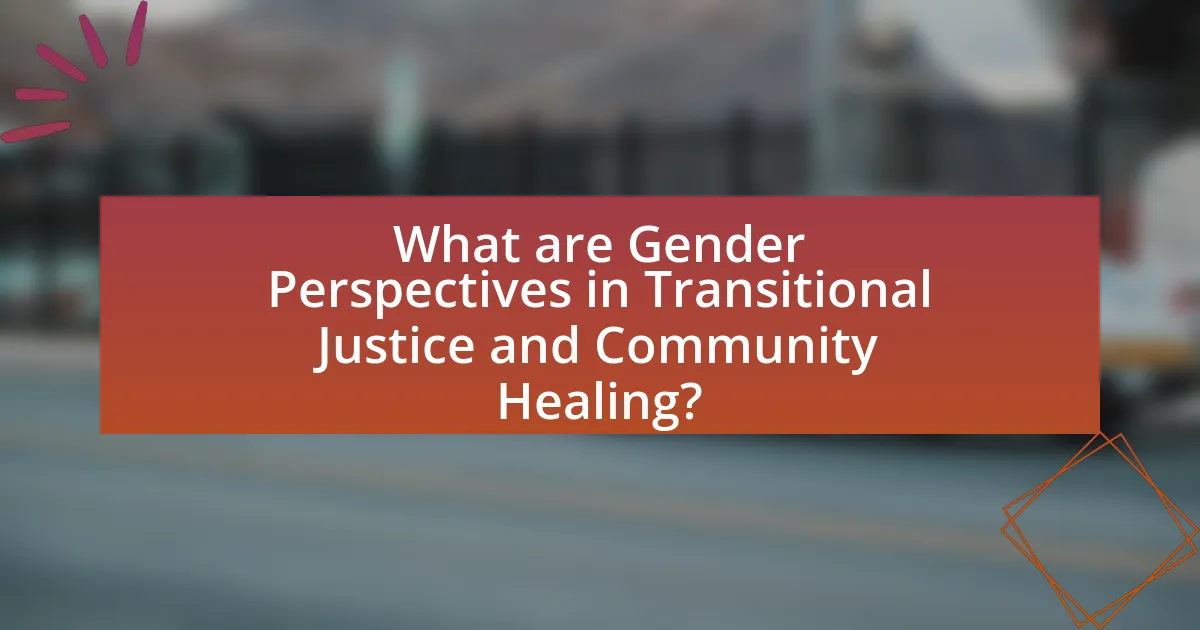
What are Gender Perspectives in Transitional Justice and Community Healing?
Gender perspectives in transitional justice and community healing refer to the integration of gender analysis into processes that address past human rights violations and promote societal recovery. These perspectives emphasize the distinct experiences and needs of different genders, particularly how women and marginalized groups are disproportionately affected by conflict and injustice. For instance, studies show that women often face specific forms of violence, such as sexual violence, which necessitates tailored responses in transitional justice mechanisms. Furthermore, incorporating gender perspectives can enhance community healing by fostering inclusive dialogue and ensuring that all voices are represented in the reconciliation process, ultimately leading to more sustainable peace outcomes.
How do gender perspectives influence transitional justice processes?
Gender perspectives significantly influence transitional justice processes by ensuring that the experiences and needs of all genders are recognized and addressed. This inclusion leads to more comprehensive and equitable justice outcomes, as evidenced by the United Nations Security Council Resolution 1325, which emphasizes the importance of women’s participation in peace and security processes. Research indicates that when women are involved in transitional justice mechanisms, such as truth commissions and reparations programs, the processes are more likely to address gender-based violence and promote societal healing. For instance, the International Center for Transitional Justice highlights that gender-sensitive approaches can lead to more effective accountability and reconciliation efforts, ultimately fostering sustainable peace.
What specific gender issues arise during transitional justice?
Specific gender issues that arise during transitional justice include the underrepresentation of women in decision-making processes, the prevalence of gender-based violence, and the need for gender-sensitive reparations. Women often face systemic barriers that limit their participation in transitional justice mechanisms, leading to a lack of representation in truth commissions and legal proceedings. Additionally, transitional justice processes frequently address wartime sexual violence, yet they may inadequately respond to the ongoing gender-based violence that persists in post-conflict societies. Research indicates that without a gender-sensitive approach, reparations may fail to meet the specific needs of women, further entrenching gender inequalities. For instance, the UN Women report “The Global Study on the Implementation of United Nations Security Council Resolution 1325” highlights that women’s voices are often marginalized in peace negotiations and post-conflict reconstruction efforts, underscoring the critical need for inclusive frameworks in transitional justice.
How do these issues affect community healing?
Issues related to gender perspectives in transitional justice significantly hinder community healing by perpetuating trauma and marginalization. When gender-based violence and discrimination are not adequately addressed, affected individuals often experience prolonged psychological distress, which obstructs collective recovery efforts. Research indicates that communities that incorporate gender-sensitive approaches in transitional justice processes, such as the inclusion of women’s voices and experiences, tend to achieve more effective healing outcomes. For instance, the United Nations has highlighted that inclusive justice mechanisms can lead to greater social cohesion and resilience, as they validate the experiences of all community members and foster a sense of belonging.
Why is it important to incorporate gender perspectives in transitional justice?
Incorporating gender perspectives in transitional justice is crucial because it ensures that the experiences and needs of all genders are recognized and addressed, leading to more equitable and effective justice outcomes. Gender-based violence and discrimination are often prevalent in conflict and post-conflict settings, and failing to consider these issues can perpetuate existing inequalities and hinder community healing. Research by the United Nations indicates that when gender perspectives are integrated into transitional justice processes, it enhances the legitimacy and sustainability of peace efforts, as it fosters inclusivity and acknowledges the diverse impacts of conflict on different genders.
What are the potential consequences of neglecting gender perspectives?
Neglecting gender perspectives can lead to significant inequities in transitional justice processes and community healing efforts. When gender perspectives are overlooked, the unique experiences and needs of different genders, particularly women and marginalized groups, are often ignored, resulting in incomplete or ineffective justice outcomes. For instance, research by the United Nations indicates that excluding women from peace negotiations can lead to agreements that fail to address the root causes of conflict, ultimately perpetuating cycles of violence and instability. Furthermore, neglecting gender perspectives can hinder community healing by failing to acknowledge and validate the trauma experienced by all genders, which is essential for comprehensive recovery and reconciliation.
How can gender-inclusive approaches enhance justice outcomes?
Gender-inclusive approaches enhance justice outcomes by ensuring that the needs and experiences of all genders are recognized and addressed within the justice system. This inclusivity leads to more comprehensive and equitable legal processes, as evidenced by studies showing that when women and marginalized genders participate in transitional justice mechanisms, the resulting policies are more effective in addressing the root causes of conflict and violence. For instance, the United Nations Security Council Resolution 1325 emphasizes the importance of women’s participation in peace and security processes, demonstrating that gender-inclusive strategies can lead to more sustainable peace and justice outcomes.
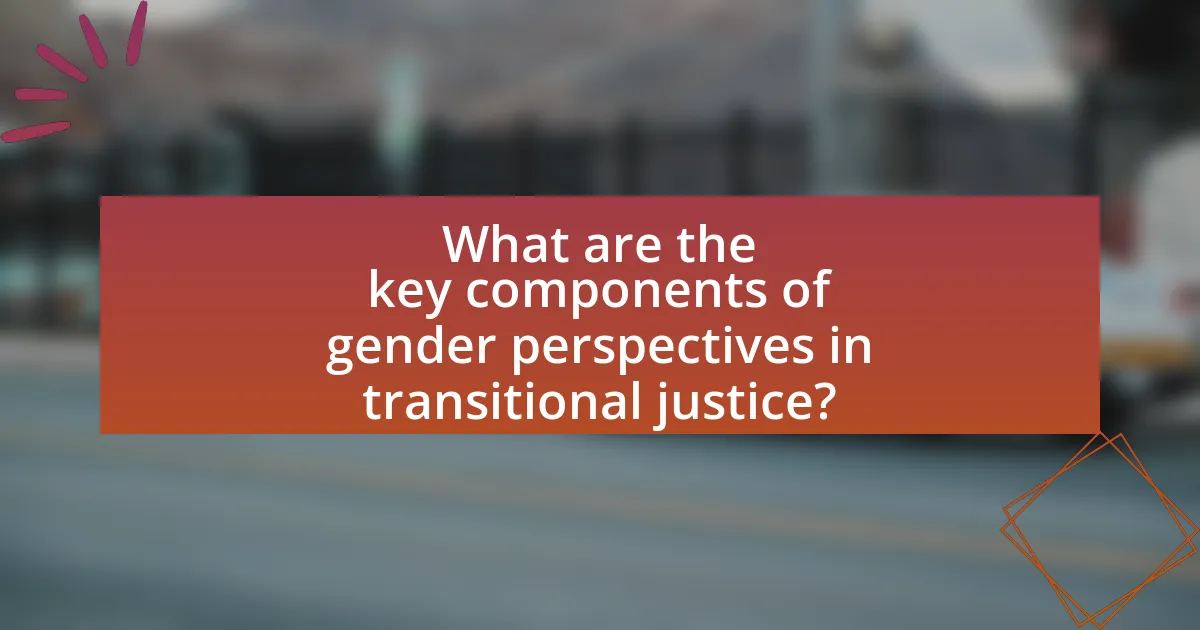
What are the key components of gender perspectives in transitional justice?
The key components of gender perspectives in transitional justice include the recognition of gender-based violence, the inclusion of women’s voices in decision-making processes, and the acknowledgment of the different impacts of conflict on various genders. Gender-based violence, such as sexual violence during conflicts, must be addressed to ensure accountability and justice. Women’s participation in peace negotiations and post-conflict reconstruction is essential for creating inclusive and sustainable solutions. Additionally, understanding how men and women experience conflict differently informs policies and practices that promote equitable healing and reconciliation. These components are supported by frameworks like the United Nations Security Council Resolution 1325, which emphasizes the importance of women’s roles in peace and security.
How do different gender identities experience transitional justice?
Different gender identities experience transitional justice in distinct ways, influenced by their unique social, cultural, and political contexts. For instance, women often face gender-specific violence and discrimination that necessitates tailored approaches in transitional justice processes, such as the inclusion of sexual violence as a war crime. Research by the United Nations indicates that women are disproportionately affected by conflict-related sexual violence, highlighting the need for gender-sensitive mechanisms in justice systems. Additionally, non-binary and transgender individuals frequently encounter systemic marginalization and violence, which can lead to their exclusion from traditional transitional justice frameworks. Studies show that inclusive practices, such as recognizing diverse gender identities in truth commissions and reparations programs, can enhance the effectiveness of transitional justice by addressing the specific harms experienced by these groups. Thus, acknowledging and integrating the experiences of various gender identities is crucial for achieving comprehensive and equitable transitional justice.
What unique challenges do women face in transitional justice contexts?
Women face unique challenges in transitional justice contexts, primarily due to systemic gender inequalities and the specific nature of their experiences during conflict. These challenges include underrepresentation in decision-making processes, where women often lack a voice in shaping justice mechanisms, leading to a failure to address their specific needs and experiences. Additionally, women frequently encounter barriers to accessing justice, such as societal stigma, lack of legal awareness, and inadequate support services, which can hinder their ability to seek redress for gender-based violence and other crimes. Research indicates that transitional justice processes often overlook the gendered dimensions of violence, resulting in inadequate recognition of women’s experiences and contributions to peacebuilding. For instance, the United Nations Security Council Resolution 1325 emphasizes the importance of women’s participation in peace and security processes, yet implementation remains inconsistent, highlighting the ongoing challenges women face in these contexts.
How do LGBTQ+ individuals navigate transitional justice processes?
LGBTQ+ individuals navigate transitional justice processes by advocating for their rights and recognition within these frameworks, often facing unique challenges due to historical marginalization. They engage in community organizing, legal advocacy, and participation in truth commissions to ensure their experiences of violence and discrimination are acknowledged. For instance, in South Africa, the Truth and Reconciliation Commission included testimonies from LGBTQ+ individuals, highlighting the need for inclusive narratives in transitional justice. This involvement not only seeks accountability but also aims to foster healing and reconciliation within their communities, as evidenced by initiatives that address both past injustices and current inequalities.
What role do cultural norms play in shaping gender perspectives?
Cultural norms significantly influence gender perspectives by establishing the expectations and behaviors deemed appropriate for different genders within a society. These norms dictate roles, responsibilities, and power dynamics, often reinforcing stereotypes that can marginalize or empower individuals based on their gender. For instance, in many cultures, traditional norms may promote male dominance in leadership roles, while women are often relegated to caregiving and domestic responsibilities. This can be evidenced by the World Economic Forum’s Global Gender Gap Report, which highlights disparities in political representation and economic participation across various countries, illustrating how cultural norms shape gender roles and limit opportunities for women. Thus, cultural norms are foundational in constructing and perpetuating gender perspectives, impacting both individual identities and broader societal structures.
How can cultural sensitivity improve transitional justice initiatives?
Cultural sensitivity can significantly improve transitional justice initiatives by ensuring that the processes and outcomes are respectful and relevant to the diverse cultural contexts of affected communities. When transitional justice mechanisms incorporate cultural values and practices, they foster greater community engagement and trust, which are essential for effective healing and reconciliation. For instance, in post-conflict societies, recognizing and integrating local customs and traditions can enhance the legitimacy of justice processes, as seen in the Truth and Reconciliation Commission in South Africa, which emphasized restorative justice principles rooted in African cultural practices. This approach not only addresses the needs of victims but also promotes social cohesion by validating the cultural identities of all stakeholders involved.
What are examples of culturally informed gender approaches in justice?
Culturally informed gender approaches in justice include restorative justice practices that integrate community values and gender-specific needs, such as the use of traditional dispute resolution mechanisms that involve women in decision-making processes. For instance, in some Indigenous communities, women’s councils play a crucial role in mediating conflicts and addressing gender-based violence, ensuring that cultural norms and gender perspectives are respected. Additionally, programs like the “Gender Justice” initiative in South Africa focus on incorporating local customs and gender dynamics into legal frameworks, promoting women’s rights while respecting cultural contexts. These approaches are validated by research indicating that culturally sensitive methods enhance the effectiveness of justice systems by fostering community trust and participation.
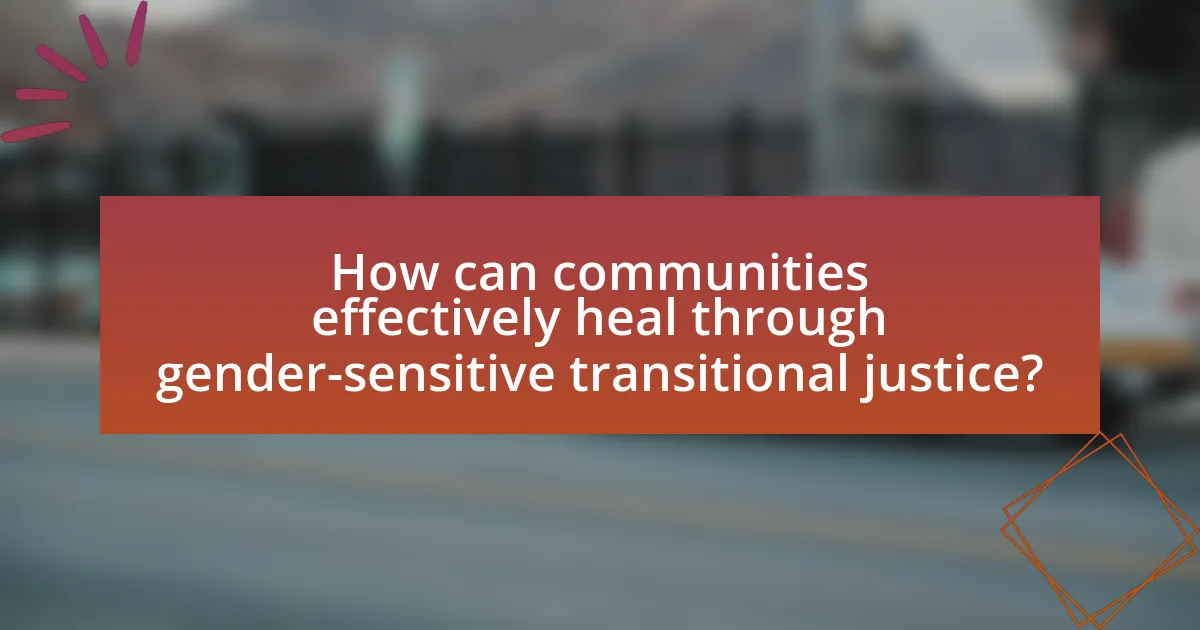
How can communities effectively heal through gender-sensitive transitional justice?
Communities can effectively heal through gender-sensitive transitional justice by integrating women’s experiences and needs into the justice process. This approach acknowledges the specific harms faced by women during conflicts, such as sexual violence, and ensures their voices are included in truth-telling, reparations, and institutional reforms. Research indicates that when transitional justice mechanisms prioritize gender sensitivity, they foster greater community trust and participation, leading to more sustainable peace. For instance, the UN Women report “The Global Study on the Implementation of United Nations Security Council Resolution 1325” highlights that women’s involvement in peace processes significantly increases the likelihood of lasting peace and stability.
What strategies promote community healing in gender-sensitive frameworks?
Strategies that promote community healing in gender-sensitive frameworks include inclusive dialogue, trauma-informed care, and empowerment initiatives. Inclusive dialogue fosters participation from diverse gender groups, ensuring that all voices are heard and valued, which is essential for collective healing. Trauma-informed care addresses the specific needs of individuals affected by gender-based violence, recognizing the impact of trauma on mental health and community dynamics. Empowerment initiatives, such as skills training and economic opportunities for marginalized genders, help rebuild agency and resilience within the community. These strategies are supported by research indicating that gender-sensitive approaches lead to more effective healing processes, as they acknowledge and address the unique experiences and needs of different genders in the aftermath of conflict or trauma.
How can storytelling and narrative play a role in healing?
Storytelling and narrative can facilitate healing by providing individuals with a means to express their experiences and emotions, thereby fostering understanding and connection. This process allows individuals to reframe their trauma, making it more manageable and less isolating. Research indicates that narrative therapy, which emphasizes the importance of personal stories, can lead to significant improvements in mental health outcomes, as evidenced by a study published in the Journal of Clinical Psychology, where participants reported reduced symptoms of depression and anxiety after engaging in narrative practices. By sharing their stories, individuals not only validate their experiences but also contribute to collective healing within communities, particularly in contexts of transitional justice where shared narratives can promote reconciliation and social cohesion.
What community-led initiatives have successfully integrated gender perspectives?
Community-led initiatives that have successfully integrated gender perspectives include the Women’s Peace and Humanitarian Fund (WPHF) and the UN Women’s “Safe Cities” initiative. The WPHF supports local women’s organizations in conflict-affected areas, providing funding for projects that address gender-based violence and promote women’s participation in peace processes. For example, in countries like Colombia and Yemen, the WPHF has empowered women to take leadership roles in community decision-making, directly influencing peace negotiations. The “Safe Cities” initiative focuses on creating safe public spaces for women and girls, addressing issues such as harassment and violence in urban areas. This initiative has been implemented in cities like Cairo and Delhi, where local communities have collaborated with authorities to develop strategies that enhance safety and promote gender equality. These initiatives demonstrate effective integration of gender perspectives by prioritizing women’s voices and addressing specific needs in transitional justice and community healing contexts.
What are the best practices for implementing gender perspectives in transitional justice?
The best practices for implementing gender perspectives in transitional justice include ensuring women’s participation in decision-making processes, integrating gender analysis into all aspects of transitional justice mechanisms, and addressing specific gender-based harms. Women’s participation is crucial as it leads to more comprehensive and representative outcomes; for instance, studies show that when women are involved in peace negotiations, the resulting agreements are 35% more likely to last at least 15 years. Integrating gender analysis helps identify the unique experiences and needs of different genders, ensuring that justice mechanisms are responsive and effective. Additionally, addressing gender-based harms, such as sexual violence, is essential for achieving accountability and healing, as highlighted by the United Nations Security Council Resolution 1325, which emphasizes the importance of addressing the impact of conflict on women and girls.
How can stakeholders collaborate to ensure gender inclusivity?
Stakeholders can collaborate to ensure gender inclusivity by establishing multi-stakeholder partnerships that prioritize diverse representation in decision-making processes. These partnerships can include government agencies, non-governmental organizations, community groups, and private sector entities, all working together to create policies and programs that address the specific needs of different genders. For instance, the United Nations has emphasized the importance of including women’s voices in peace negotiations, highlighting that when women are involved, the likelihood of sustainable peace increases by 35%. This collaboration can also involve conducting gender-sensitive assessments to identify barriers to inclusivity and implementing training programs that promote gender awareness among stakeholders.
What resources are available for communities seeking to adopt gender-sensitive approaches?
Communities seeking to adopt gender-sensitive approaches can access various resources, including guidelines, toolkits, and training programs specifically designed for this purpose. For instance, the United Nations Development Programme (UNDP) provides a Gender Equality Strategy that outlines best practices and frameworks for integrating gender perspectives into community initiatives. Additionally, organizations like the Global Fund for Women offer funding and support for projects that promote gender equality and empower women in transitional justice contexts. Research studies, such as those published by the International Center for Transitional Justice, also provide valuable insights and methodologies for implementing gender-sensitive practices effectively. These resources collectively support communities in fostering inclusive and equitable environments.
What lessons can be learned from past transitional justice efforts regarding gender?
Past transitional justice efforts reveal that integrating gender perspectives is crucial for achieving comprehensive accountability and healing. For instance, the International Criminal Tribunal for the former Yugoslavia (ICTY) highlighted the importance of recognizing sexual violence as a war crime, which led to greater awareness and legal recognition of gender-based violence in conflict settings. Additionally, the Truth and Reconciliation Commission in South Africa demonstrated that including women’s voices in the reconciliation process fosters community healing and ensures that the specific needs of women are addressed. These examples underscore that effective transitional justice must prioritize gender inclusivity to promote lasting peace and justice.
What case studies illustrate successful gender integration in transitional justice?
Case studies that illustrate successful gender integration in transitional justice include the post-conflict processes in Rwanda and Liberia. In Rwanda, the Gacaca courts incorporated women’s voices and experiences, leading to significant representation of women in the justice process, with women making up over 40% of judges. This inclusion helped address gender-based violence and fostered community healing. In Liberia, the Truth and Reconciliation Commission actively engaged women and emphasized their experiences during the civil war, resulting in recommendations that specifically addressed women’s rights and needs. These cases demonstrate how gender integration can enhance the effectiveness and inclusivity of transitional justice mechanisms.
How can these lessons inform future practices in community healing?
Lessons from gender perspectives in transitional justice can inform future practices in community healing by emphasizing the importance of inclusive participation and addressing specific needs of marginalized groups. For instance, integrating women’s voices in peacebuilding processes has been shown to lead to more sustainable outcomes, as evidenced by the United Nations Security Council Resolution 1325, which highlights the role of women in conflict resolution and peace processes. Furthermore, recognizing the unique trauma experienced by different genders can guide the development of targeted support services, enhancing the effectiveness of healing initiatives. This approach not only fosters a sense of ownership among community members but also promotes resilience and social cohesion, ultimately leading to more effective community healing practices.
